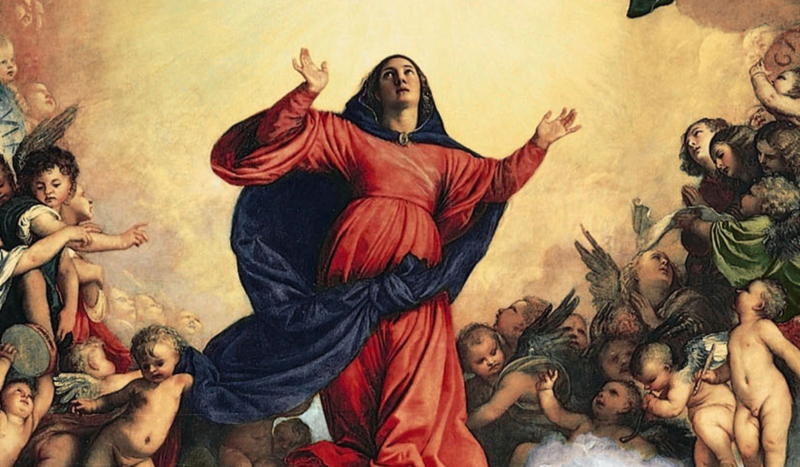
The idea that the Blessed Virgin Mary was assumed, body and soul, into heaven is a dearly held dogma of the Catholic Church. Titian’s depiction of this glorious moment honoring Mary is a timeless and treasured work of art full of warm and welcoming colors and symbolically rich composition.
The unique shape of the work, a rectangle with a curved top, immediately draws the eye to the two main shapes in the composition. On the top, a perfect golden circle, with Our Lady at the center. On the bottom, a solid rectangle, encapsulating the sky and the earth. Once again, we see the eternal and heavenly represented by a never ending circle, and the worldly and earthly depicted by a structured and stagnant rectangle.
The focal point of the painting is Mary herself who seems to step and spin upwards towards heaven with a look of ecstasy on her face. The loving gaze of God the Father looks down on his handmaid. The choirs of angels and cherubims support the celestial clouds as all of their movement is pulled magnetically towards Our Lady, the focal point at the center.
The classic Titian red is prominent in the color pallet and is seen throughout the painting in a balanced and bold way. Two figures on the ground dressed in red sweep the eye upward to Mary and then further upward to God who is also depicted in the similar red. Nearly every face in the painting echoes the heavenly magnetism by gazing upward. This can symbolically be understood as a nod to the role of Mary’s intercession since it is nearly impossible to tell if the people are looking towards God directly, or at God through and past the figure of Mary.
Although there is not a direct Gospel account of the Assumption, it is nonetheless alluded to in both the Old Testament and Revelation and has been consistently held through tradition. The Assumption is described in the Catechism of the Catholic Church as “a singular participation in her Son’s Resurrection and an anticipation of the resurrection of other Christians” (CCC 966). On this feast, honoring the Mother of God as “Queen over all things” (CCC 966), let us ask for her intercession in our lives so that one day we too may join her in heavenly communion with her Son.

